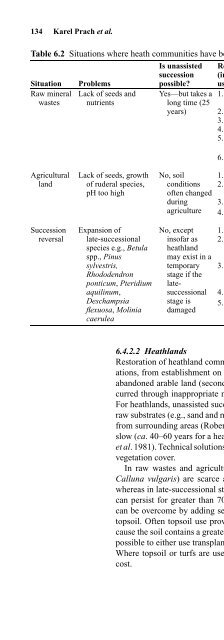Linking Restoration and Ecological Succession (Springer ... - Inecol
Linking Restoration and Ecological Succession (Springer ... - Inecol
Linking Restoration and Ecological Succession (Springer ... - Inecol
You also want an ePaper? Increase the reach of your titles
YUMPU automatically turns print PDFs into web optimized ePapers that Google loves.
134 Karel Prach et al.<br />
Table 6.2 Situations where heath communities have been restored.<br />
Situation Problems<br />
Raw mineral<br />
wastes<br />
Agricultural<br />
l<strong>and</strong><br />
<strong>Succession</strong><br />
reversal<br />
Lack of seeds <strong>and</strong><br />
nutrients<br />
Lack of seeds, growth<br />
of ruderal species,<br />
pH too high<br />
Expansion of<br />
late-successional<br />
species e.g., Betula<br />
spp., Pinus<br />
sylvestris,<br />
Rhododendron<br />
ponticum, Pteridium<br />
aquilinum,<br />
Deschampsia<br />
flexuosa, Molinia<br />
caerulea<br />
Is unassisted<br />
succession<br />
possible?<br />
Yes—but takes a<br />
long time (25<br />
years)<br />
No, soil<br />
conditions<br />
often changed<br />
during<br />
agriculture<br />
No, except<br />
insofar as<br />
heathl<strong>and</strong><br />
may exist in a<br />
temporary<br />
stage if the<br />
latesuccessional<br />
stage is<br />
damaged<br />
<strong>Restoration</strong> methods<br />
(in approximate order<br />
used) Selected references<br />
1. Regrade site, add organic<br />
amendments if possible<br />
2. Add seed<br />
3. Add fertilizerr<br />
4. Use nurse crops<br />
5. Transplants—plants<br />
or turfs<br />
6. Grazing control<br />
1. Acidify soils<br />
2. Reduce fertility,<br />
(e.g., by sod cutting)<br />
3. Grazing control<br />
4. Add seeds<br />
1. Reduce fertility<br />
2. Control late-successional<br />
species: mechanical or<br />
herbicidal methods<br />
3. Create conditions for<br />
heathl<strong>and</strong> species to<br />
germinate<br />
4. Add seeds<br />
5. Grazing control<br />
Roberts et al. (1981),<br />
Anonymous (1988)<br />
Pywell et al (1994,<br />
1997), Davy et al.<br />
(1998), Dunsford<br />
et al. (1998), Owen<br />
<strong>and</strong> Marrs (2000a,b)<br />
Marrs (1988),<br />
Milligan et al.<br />
(2004)<br />
6.4.2.2 Heathl<strong>and</strong>s<br />
<strong>Restoration</strong> of heathl<strong>and</strong> communities has been described in a number of situations,<br />
from establishment on raw mineral wastes (primary succession), from<br />
ab<strong>and</strong>oned arable l<strong>and</strong> (secondary succession), <strong>and</strong> where succession has occurred<br />
through inappropriate management of existing heathl<strong>and</strong>s (Table 6.2).<br />
For heathl<strong>and</strong>s, unassisted succession is a serious possibility for restoration of<br />
raw substrates (e.g., s<strong>and</strong> <strong>and</strong> mining wastes) where there is sufficient seed rain<br />
from surrounding areas (Roberts et al. 1981). On s<strong>and</strong> wastes, succession was<br />
slow (ca. 40–60 years for a heathl<strong>and</strong> to develop) <strong>and</strong> highly variable (Roberts<br />
et al. 1981). Technical solutions can accelerate this process <strong>and</strong> provide a greater<br />
vegetation cover.<br />
In raw wastes <strong>and</strong> agricultural l<strong>and</strong>, seeds of heathl<strong>and</strong> species (usually<br />
Calluna vulgaris) are scarce <strong>and</strong> may even be absent (Pywell et al. 1997),<br />
whereas in late-successional st<strong>and</strong>s invaded by woodl<strong>and</strong> Calluna, seed banks<br />
can persist for greater than 70 years (Pywell et al. 2002b). Seed limitations<br />
can be overcome by adding seeds, shoots with the attached seed capsules, or<br />
topsoil. Often topsoil use provides a more diverse flora than seeds alone because<br />
the soil contains a greater species diversity (Pywell et al. 1994). It is also<br />
possible to either use transplanted turfs or nursery-grown plants (Webb 2002).<br />
Where topsoil or turfs are used there are implications for the donor site <strong>and</strong><br />
cost.

















